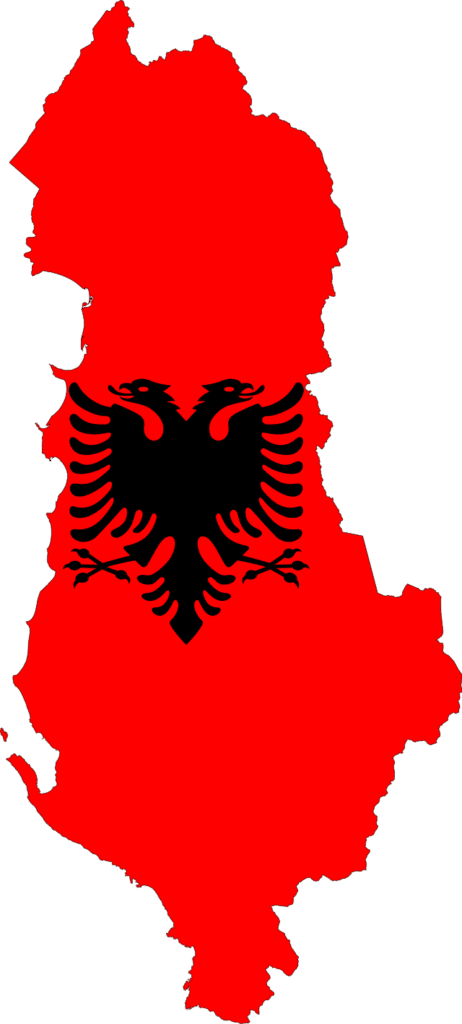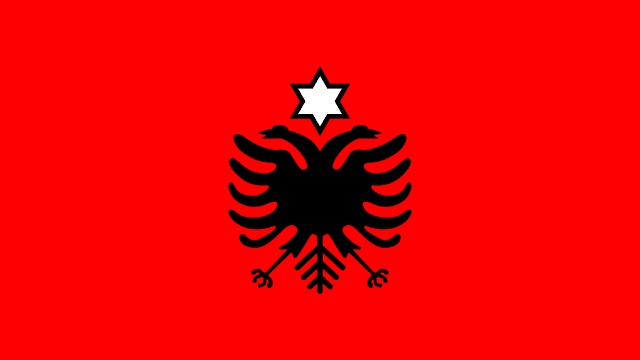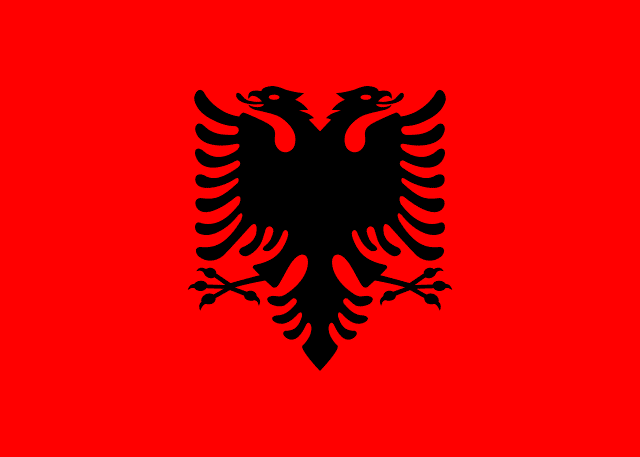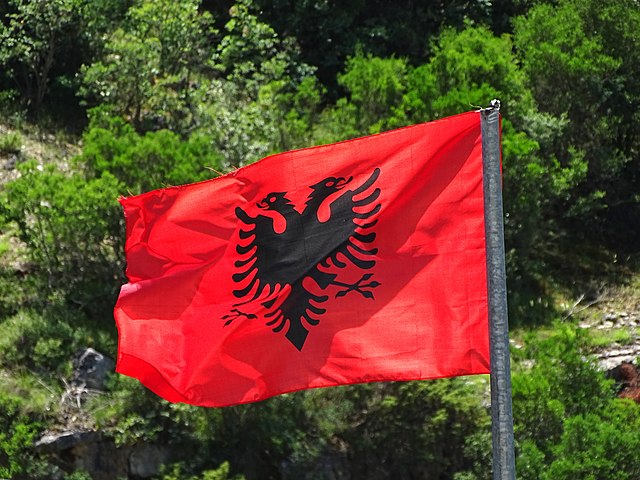Despite having a smaller population than many other European nations, Albanians are among the nicest people in the world, making visitors from all over the world feel at home. Albania is highly renowned for its flag, which is one of the most distinctive flags used by any country in the world.
In this article, you’ll learn about the history, significance, and symbolism of the Albania flag, as well as some interesting information about the nation.
Characteristics Of Country Albania
Did you know that the characteristics of the country of Albania are represented on its national flag? That’s why it’s essential to first overview the geographical location and demographic situation of Algeria. The nation of Albania is situated on southeast Europe’s Balkan Peninsula. Its coastline includes both the Adriatic and Ionian Seas in the west, and it is home to over 2.8 million people.
Serbia (Kosovo) borders Albania to the northeast, Montenegro to the north, the Republic of Macedonia to the east, and Greece to the southeast. It’s important to note that Croatia and Italy have marine boundaries with the country. With a surface area of around 28,748 km2, the country has a population density of 102 individuals per square kilometer or 39 per square mile. The nation is ranked 105 globally for population density and 144 globally for the area.
Albania is a republic with a unitary parliamentary system. In a multi-party system, the Prime Minister of Albania serves as the head of government, while the President of Albania is the head of state. Although Albanian is the official language, people also converse in Italian, Greek, French, German, and English.
The standard time in Albania is observed at UTC +02:00. Albania has 36 districts in total but no states or provinces.
Albania is known for its subtropical Mediterranean climate. The majority of the nation’s landscape is made up of mountains, hills, and the coastline, and the nation’s geology and climate contribute to an extensive network of rivers and lakes. The country is characterized by both rainy and mild winters and dry, scorching summers.
A Brief History of Albania
The history of the country has a strong impact and influence on the national emblem, and the Albania flag is no exception. Due to its position, Albania is one of those nations or regions that has been governed by several empires and other nations. It has served as a key land mass during several international battles because of its location close to Greece and along the Adriatic Sea.
Around 2000 BC, a band of people known as the Illyrians began to live in the area. One of the earliest empires to invade the region was the Roman Empire, and Albania was a part of both the Roman and the Byzantine or Eastern Roman empires. The Ottoman Empire took over in the 1300s.
During this period, a sizable portion of the populace converted to Islam. Under the guidance of their national hero Gjergj Kastrioti Skenderbeu, the Albanians were able to briefly secede from the Ottomans in the middle of the 14th century. But the Ottomans quickly regained power.
Throughout history, the Albanians engaged in several conflicts to gain their freedom. They temporarily attained it a few times, but it wasn’t until the early 1900s that they gained national recognition.
Germany and Italy both invaded and conquered Albania during World War II. The communist party assumed power after the war. Before ultimately holding democratic elections in 1992, the nation would stay under communist governance for the following 40+ years.
Sali Berisha was Albania’s first president to be chosen democratically. However, the nation is now still experiencing considerable unrest as the democratic and communist parties compete for supremacy. Although the nation wishes to become a member of the European Union, there are still a number of requirements that must be satisfied.

Development Stages of Albania Flag
Albania Flag During Roman Empire Reign
The Eastern Roman Empire, which reigned over Albania for a significant portion of the country’s early history, served as the inspiration for the Albania flag. The nobles that came to reign in Albania during the last years of the Roman Empire adopted the double-headed eagles and crimson banners used to represent the Emperors as their own. Even when Albania was included in the Ottoman Empire as it grew throughout the Balkans, it continued to be a symbol of the country.
When the Kastrioti launched a rebellion against the Ottoman Empire that resulted in a brief period of independence for some portions of Albania from 1443 to 1478, his coat of arms, which features a double-headed eagle on a crimson background, became renowned. The double-headed eagle of the House of Palaiologos, one of the governing dynasties of the Byzantine Empire, is usually believed to be the ancestor of the modern eagle.
Flag Of Nationalist Movement For Albania
In the nineteenth century, a nationalist movement for Albanian independence was founded. When the Albanian leader Isa Boletin revolted against Turkey in 1910, he flew the flag. In June 1911, an autonomous administration was established, and Prishtina flew a crimson flag bearing a black double-headed eagle. Several weeks later, the flag was also flying in southern Albania.
Albanians seized Üsküb in May 1912, and Turkey recognized Albania’s independence in June 1912. Ismail Qemali proclaimed Albania’s independence at Vlora on November 28, 1912, during the First Balkan War, and hoisted a flag bearing the black eagle of Skanderbeg on a red background. When the movement gained independence in 1912, a small modification of the movement’s flag that had a white star above the eagle came into use. The movement’s banner resembled the contemporary Albania flag.

Second World War Period
Albania was divided among Serbia, Montenegro, and Greece following the Second Balkan War in 1913. However, on July 29, 1913, during a summit in London, the then-six major nations formally recognized German prince Wilhelm von Wied’s Albania as an independent principality.
He arrived in Durrs but left six months later due to a lack of backing from outside and a Muslim uprising in central Albania. The used flag featured a redrawn double-headed eagle with a white five-pointed star and a yellow beak and talons.
In 1914, a brand new variant of the flag was unveiled. It was similar to the former flag, but the eagle was shown in more detail, and its feet and beaks were tinted with gold rather than the pure black seen in most other versions.

Principality Of Albania Flag
The star above the eagle was removed from the flag in 1920, which resulted in a minor modification to the flag. The nation was occupied by several troops throughout the First World War. At a Congress in Lushnja in 1920, when the Italians had finally withdrawn, a new administration was established. Orthodox priest Fan Noli, who had previously resided in the USA, was appointed prime minister and regent on July 17, 1924. When Ahmet Zogu was elected president in 1925, a republic was established, and the flag’s design was simplified.
Three years later, Zogu proclaimed himself King Zog I and established a monarchy in the nation. The double-headed eagle was now adorned with Skanderbeg’s helmet after the flag underwent yet another modification. Up until 1934, the flag’s field was a very dark red. After that, a considerably lighter hue was chosen.

Flag Of Democratic Government of Albania
When Italy invaded Albania in 1939, they added yet another modification to the flag’s design. In 1944, the communist regime replaced the Italian occupation, and a crossed hammer and sickle were added to the canton. King Zog I was declared to be overthrown, and the People’s Republic of Albania was established on January 11, 1946. The state’s name was changed to “People’s Socialist Republic of Albania” in 1976 after a new constitution was approved, but the flag remained the same.

Current Albania Flag
The communist star was removed from the national flag on April 7, 1992, marking the end of communism in that country. The “Flamur e Skenderbeut” (Skanderbeg’s flag), a red field with a black double-headed eagle, was flown by Albania once more.

Symbolism of Albania Flag
The double-headed eagle is shown in black on a background of solid red on the Albania flag. The double-headed eagle has been used as a symbol of Albania’s monarchs ever since the Middle Ages.
The Albania flag’s eagle has 25 tails. The double-headed eagle legend dates back thousands of years. Figures of double-headed eagles from the ancient era have been discovered in the country’s excavations.
The Albanians most likely took inspiration for the design from the Roman banners, which portrayed the Roman Empire.
“Shqiptar,” which is sometimes translated as “sons of eagles,” is the name Albanians give themselves. However, their affiliation with the national language also plays a role in this. On the other hand, the crimson field on the flag stands for tenacity, bravery, and gallantry, as well as the blood that the Albanians shed while fighting.

Bottom Line
The Albania flag is red with a black, double-headed eagle in silhouette in the middle.
Since the creation of the first known design, Albania flags have seen relatively little alteration. The core colors of the flag have not been modified in the slightest, and while the specifics of the national insignia have varied throughout time, the overall style of the Albania flag has stayed the same.